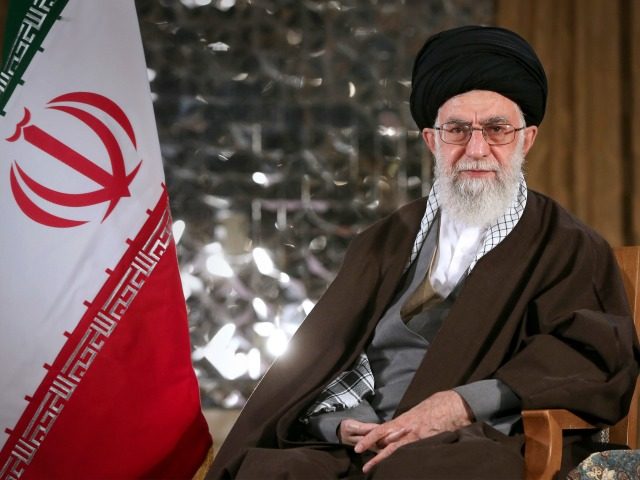Iranian Supreme Leader Ayatollah Ali Khamenei on Wednesday demanded a “jump in production” from his country’s threadbare economy to stave off the effects of U.S. sanctions, which he compared to the Wuhan coronavirus.
Khamenei took the occasion of Iran’s “Labor Week” to roll out his “Jump in Production” slogan for the coming year (which, on the Iranian calendar, began in March). He told a group of manufacturing executives via teleconference that Iran could fight off sanctions the same way it fought the coronavirus, which is actually a rather unfortunate choice of metaphor, given the carnage caused by the Iranian regime’s coronavirus policies.
As reported by Iran’s state-run PressTV, Khamenei left those unpleasant details aside to compare a strong economy with a strong immune system:
“This very coronavirus entered people’s bodies, but many did not fall ill. How did that happen?” Ayatollah Khamenei explained that a strong immune system was what enabled a successful fight against viruses.
“Should we want to liken the economy to human body, the defense system that provides the economy with security would be production,” the Leader pointed out. “In other words, the element that can neutralize invasive viruses and microbes targeting the economy and keep it healthy is production,” Ayatollah Khamenei stated.
The Leader categorized the invasive economic factors into “natural viruses” and “manufactured viruses such as sanctions and [the manipulation of] the oil price.”
“However, if we have good production [levels], we can resist these viruses,” Ayatollah Khamenei said.
Khamenei stressed that “genuine cooperation” between employees and employers would be needed to achieve this economic miracle, which he described as a “resistive economy” that could counteract “enemy maneuvers” from the United States.
Iran has experienced several major labor strikes over the past few years, in addition to protests about the generally lousy state of the ayatollah’s economy and the government’s tendency to blow public money on foreign military adventures instead of domestic relief.
Some observers suspect the pandemic has only slightly delayed another major protest by labor, and when it finally arrives, it could be much worse due to seething public resentment of how the regime botched its coronavirus response plus mounting anxieties over the Iranian economy.
Working forward from a February column on the subject by David Ignatius at the Washington Post, one might wonder if the all-consuming menace of the pandemic delayed a political reckoning for the aging revolutionary regime that began with America’s killing of Islamic Revolutionary Guard Corps (IRGC) Gen. Qasem Soleimani and the IRGC’s subsequent murder of a planeload of civilians.
Soleimani was the avatar of everything that angers many Iranian workers about their rulers’ habit of splurging on foreign troop deployments and terrorism, and the airliner shootdown created a good deal of domestic anger at the regime, especially given Tehran’s embarrassing efforts to cover it up.
The Iranian resistance anticipates even greater public anger when the Iranian people realize how extravagantly their rulers have lied about the extent of the coronavirus pandemic. On Wednesday, the opposition PMOI/MEK charged that the regime failed to conceal an enormous new wave of infections caused by sending Iranians back to work too soon, with insufficient emphasis on social distancing techniques:
By forcing people back to work, the number of people contracting the Coronavirus has accelerated across the country and the spokesman for Rouhani’s Health ministry was forced to admit it. Today, he announced the number of new patients in the last 24 hours as 1,680, which is more than double the number on May 4, which was 802, and its consequences will appear in the coming weeks.
Meanwhile, last night, the state-run TV broadcast Rouhani’s meeting with Health Ministry’s officials on May 4, during which he tried to justify the regime’s fake statistics. “There are people who are not aware of their infections; neither is any hospital, nor any toll centers. So we have to accept that number of patients in all countries around the globe may be more than what their statistics say … the same goes for the death toll … When a person (infected with Coronavirus) with an underlying disease dies, should we mention that underlying disease as the cause of death, or should we consider Coronavirus as the cause? … We can do both ways, and countries do the same.”
Saeid Namaki, regime’s Health Minister, addressing the same meeting, said, “We expected the virus would be contained as the weather gets warmer, but now our tropical provinces, like Khuzestan, Hormozgan, or Bushehr, are taking on an upward trend.”
Farhad Abol-Nejadian, president of Khuzestan University of Medical Sciences, told the state- TV’s news network, “Due to the decrease in social distancing since April 11, 2020, we have an increasing trend starting from April 20, 2020. The highest rate of infection is in Ahvaz, Bavi, Dezful, Shooshtar, and Karun… The major concentration of the outbreak is in the suburbs of the cities, where there is more economical and living restraint.”
The MEK said Rouhani is too focused on generating a sense of public optimism to help the economy recover and too confident that his officials could conceal the true number of infections and deaths. Iran’s official death toll stood at 6,486 on Thursday, but the MEK has long insisted the real number is at least five times as high, currently counting over 39,500 fatalities spread across 314 Iranian cities.

COMMENTS
Please let us know if you're having issues with commenting.